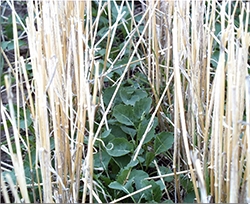
Features
Agronomy
Harvesting
Consider tall stubble this harvest
Sept. 20, 2015 - With many shorter crops this year and the need for moisture to recharge the subsoil in some areas, there may be a benefit to cutting the stubble high to catch additional snow and reduce evaporation during the next growing season. The El Nino developing is one of the strongest in recent history and for the prairie region this may mean a warmer and drier fall and winter. Climatologists are saying that the effects of this El Nino are a bit unpredictable but if the soil is not fully recharged, cutting taller stubble might be our best chance to manage this harvest to our advantage for the next growing season.
If producers have access to stripper headers or air-reels, harvesting taller stubble should be easier. However, with straight cut headers the height of the stubble can be cut a little taller than normal, to a point just before header losses start to occur. Many of the crops are shorter this year so the focus is on cutting the stubble as tall as practical. The straw and chaff need to be fine-chopped and uniformly spread to make seeding into tall stubble easy and to avoid plugging.
When the subsoil is not fully recharged with moisture and there is limited spring rains, leaving tall stubble can result in increased yields. A summary of recent research showed there was a definite yield advantage to tall stubble because it collected more snow and reduced surface evaporation during dry periods resulting in higher yields. A new observation from the 2014 published findings showed that if tall stubble was flattened or lodged, for whatever reason, the yield benefit was not there. It is important to minimize the amount of driving on fields where tall stubble technology is implemented and even consider seeding between the rows of the previous crop stubble to keep as much of the stubble standing, as seen in the photo above.
In a year when the subsoil is fully recharged with moisture from fall rains and spring snowmelt or spring rains, there is little or no benefit to tall stubble until there is a hot dry period during the growing season. Under this condition the taller stubble reduces evapotranspiration from the crop conserving the moisture for additional yield.
September 18, 2015 By Saskatchewan Agriculture
 Canola seeded between the rows of tall stubble. Consider tall stubble this harvest.
Canola seeded between the rows of tall stubble. Consider tall stubble this harvest.